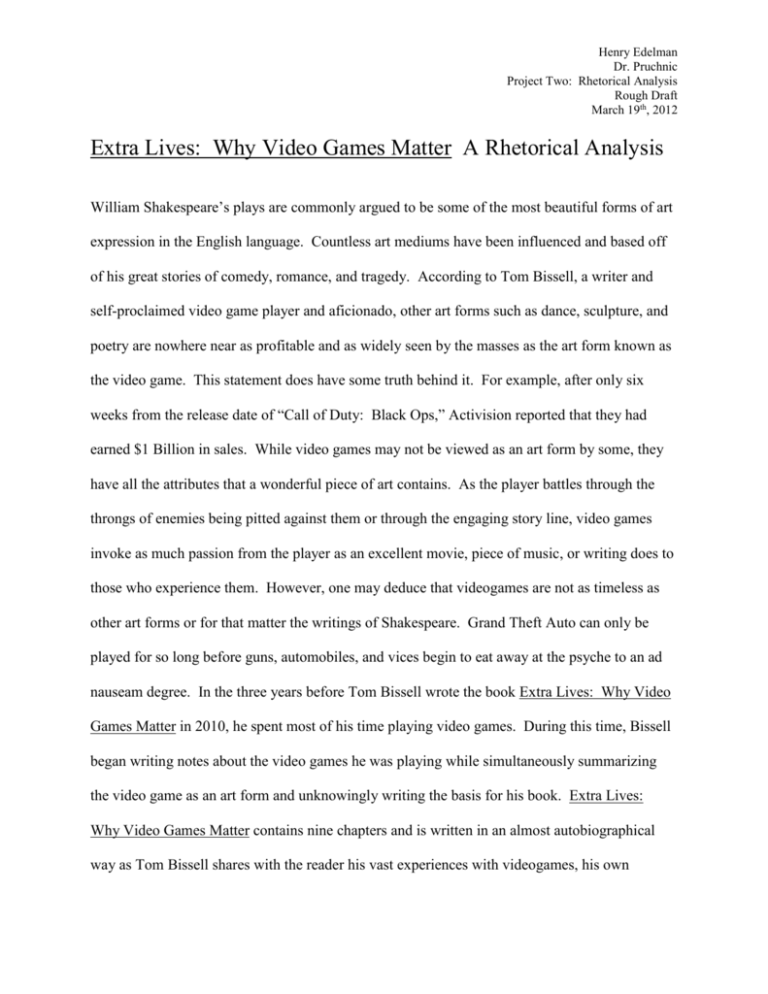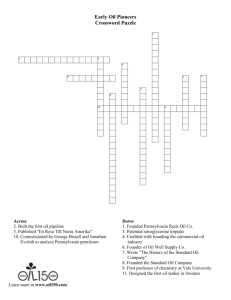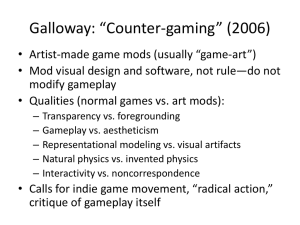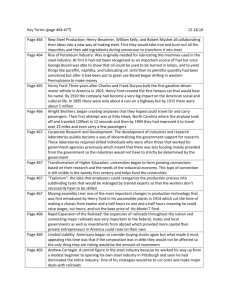Extra Lives: Why Video Games Matter
advertisement

Henry Edelman Dr. Pruchnic Project Two: Rhetorical Analysis Rough Draft March 19th, 2012 Extra Lives: Why Video Games Matter A Rhetorical Analysis William Shakespeare’s plays are commonly argued to be some of the most beautiful forms of art expression in the English language. Countless art mediums have been influenced and based off of his great stories of comedy, romance, and tragedy. According to Tom Bissell, a writer and self-proclaimed video game player and aficionado, other art forms such as dance, sculpture, and poetry are nowhere near as profitable and as widely seen by the masses as the art form known as the video game. This statement does have some truth behind it. For example, after only six weeks from the release date of “Call of Duty: Black Ops,” Activision reported that they had earned $1 Billion in sales. While video games may not be viewed as an art form by some, they have all the attributes that a wonderful piece of art contains. As the player battles through the throngs of enemies being pitted against them or through the engaging story line, video games invoke as much passion from the player as an excellent movie, piece of music, or writing does to those who experience them. However, one may deduce that videogames are not as timeless as other art forms or for that matter the writings of Shakespeare. Grand Theft Auto can only be played for so long before guns, automobiles, and vices begin to eat away at the psyche to an ad nauseam degree. In the three years before Tom Bissell wrote the book Extra Lives: Why Video Games Matter in 2010, he spent most of his time playing video games. During this time, Bissell began writing notes about the video games he was playing while simultaneously summarizing the video game as an art form and unknowingly writing the basis for his book. Extra Lives: Why Video Games Matter contains nine chapters and is written in an almost autobiographical way as Tom Bissell shares with the reader his vast experiences with videogames, his own Henry Edelman Dr. Pruchnic Project Two: Rhetorical Analysis Rough Draft March 19th, 2012 critiques and analyses, and interviews with people from all over the video game industry. In this essay I attempt to deduce the three artistic proofs of persuasion, ethos, pathos, and logos in order to provide a rhetorical analysis of Bissell’s writing. Ethos or the ethical appeal is the credibility of the author and their character. Tom Bissell, born in 1974 and raised in Escanaba Michigan, is a journalist, critic, and fiction writer. Bissell is currently an assistant professor at Portland State University since 2009. He studied English at Michigan State University and at 22, then went to Uzbekistan to volunteer in the Peace Corps teaching English and was there for seven months. He then returned to New York City to work as a book editor. He has written five books, among them Extra Lives: Why Video Games Matter was the last published in 2010. Furthermore, he was elected a Guggenheim Fellow in 2010 for creative arts in general nonfiction, and is the recipient of the Rome Prize, and the Community College Alumnus of the Year Award. Ostensibly, Bissell is a well educated and learned traveler and writer and it shows in this book. For example, he talks of his highly coveted literary fellowship in Rome and on the other end of the spectrum of how he was allowed to sit in on the then classified intelligence meetings while embedded with the Marine Corps in Iraq. Or how between 2001 and 2006 during which he wrote several books and published more than fifty pieces of magazine journalism and criticism with approximately a total output of forty five hundred manuscript pages is impressive. He writes with an effervescent flow and witty satirical eloquent style. Bissell is very articulate and it shows in the way his writing and complex verbiage is chosen. The tone of the writing is informal and the audience is subject to humor, analogies, and Bissell’s analysis of video games. Bissell in the author’s note admits that this book is somewhat “eccentric” and at times very “personal.” Bissell writes on page, “As for Henry Edelman Dr. Pruchnic Project Two: Rhetorical Analysis Rough Draft March 19th, 2012 video games, very few people over the age of forty would recognize them as even a lower form of art. I am always wavering as to where I would locate video games along art’s fairly forgiving sliding scale. Video games are obviously and manifestly a form of popular art, and every form of art, popular or otherwise, has its ghettos, from the crack houses along Michael Bay Avenue to the tubercular prostitutes coughing at the corner of Steele and Patterson. The video game is the youngest and, increasingly, the most dominant popular art form of our time. To study the origins of any popular new medium is to become an archeologist of skeptical opprobrium. It seems to me that anyone passionate about video games has better things to do than walk chin-first into sucker punch arguments about whether they qualify as art. Those who do not believe video games are or ever will be art deserve nothing more goading or indulgent than a smile.” I feel this quote represents all the rhetorical techniques presented by the book as a whole. Tom Bissell is witty, articulate, and humorous as well as analyzes the subject of videos games as an art form using rhetorical techniques in order to convince the audience of his views. Pathos or the emotional appeal is used to persuade and invoke an emotional response from the audience. Bissell’s passion for videogames transcends an average person’s appeal for them. In fact, for three years Bissell was addicted to cocaine and even compared its addictive nature to video games. His passion for video games is always present to the reader and one cannot help but enjoy this persuasion. For example as he describes with great detail a gory scene in the video game Fallout 3 on page 8, “…as I turned to bash in the brainpan of a radioactive ghoul, noticed the playful, lifelike way in which the high-noon sunlight streaked along the grain of my sledgehammer’s wooden handle. During such moments, it is hard not to be startled-even movedby the care poured into the game’s smallest atmospheric details.” It is with this attention to Henry Edelman Dr. Pruchnic Project Two: Rhetorical Analysis Rough Draft March 19th, 2012 detail that Bissell distinguishes himself from the average gamer. Bissell’s passion for video games was further verified in his description of his emotions experienced while playing the video game Left 4 Dead, in which a group of four survivors encounters the endless onslaught of ravenous zombies. Bissell described his experience as emotions more intensely vivid than any he had ever felt while reading a novel or watching a film or listening to a piece of music. This is a very profound statement and represents a key theme of the book; the comparison between video games and other art mediums. On page 38, Bissell puts to rest any argument between games and other art forms. “When I am being entertained, I am also being manipulated. I am allowing myself to be manipulated. I am, in other words, surrendering. When I watch television, one of our less exalted forms of popular entertainment, I am surrendering to the inevitability of commercials amid bite-sized narrative blocks. When I watch a film, the most imperial form of popular entertainment-particularly when experienced in a proper movie theaterI am surrendering most humiliatingly, for the film begins at a time I cannot control, has nothing to sell me that I have not already purchased, and goes on whether or not I happen to be in my seat. When I read a novel I am not only surrendering; I am allowing my mind to be occupied by a colonizer of uncertain intent. Entertainment takes it as a given that I cannot affect it other than in brutish, exterior ways: turning it off, leaving the theater, pausing the disc, stuffing in a bookmark, underlining a phrase. But for those television programs, films, and novels febrile with self-consciousness, entertainment pretends it is unaware of me, and I allow it to. Playing video games is not quite like this. The surrender is always partial. You get control and are controlled. Games are patently aware of you and have a physical dimension unlike any other form of popular entertainment. … Even though you may be granted lunar influence over a Henry Edelman Dr. Pruchnic Project Two: Rhetorical Analysis Rough Draft March 19th, 2012 game’s narrative tides, the fact that there is any narrative at all reminds you that a presiding intelligence exists within the game along with you, and it is this sensation that invites the otherwise unworkable comparisons between games and other forms of narrative art.” Put another way by the game designer Jesse Schell, if you compare games to “linear entertainment” experiences such as novels and movies, while linear experiences involve technology, a story, and art they do not involve motion, and motion makes a video game a video game. Bissell also argues that story and game combine to create an experience. He states that the game is not the experience, the game enables the experience. Compared to movies, movies offer a more specific and predetermined type of storytelling. In comparison, games have you deciding how to tell the story because you point the character. As Bissell humorously puts it, there are not many mediums where you can “ring up Dantes and Homers and talk to them,” and with video games you can. Furthermore, early film and literature offered experimental surrealistic fantasy, but early video games depended on rudimentary technology that made realism impossible. Films in the 1920s were often in response to other films before them. For video games, newer games provided you with everything employed in older games, however the newer games were larger, and technologically and graphically much more proficient. Technology literally means “knowledge of a skill” and is greatly required in modern game design. As Bissell states, “An average game today is likely to have as much writing as it does sculpture, as much probability analysis as it does resource management, as much architecture as it does music, as much physics as it does cinematography.” Logos, or the appeal to logic, persuades an audience by the use of logic or reason. Bissell uses logos throughout the book to further explain his theories and analyses of video games and many Henry Edelman Dr. Pruchnic Project Two: Rhetorical Analysis Rough Draft March 19th, 2012 analogies to help convey his ideas. For example on page 41 Bissell states, “The impulse to explain is the Achilles’ heel of all genre work, and the most sophisticated artists within every genre know better than to expose their worlds to the sharp knife of intellection.” In this quote, Bissell uses the rhetoric of analogies, in this case the “Achilles’ heel,” in order to prove his point to his audience. Bissell’s point being that the weak point of genre work is that intellection exposes larger problems that vague works do not contain. Another example of logos is how he compares the moral dilemmas in the dystopian world of the video game Bioshock to Ayn Rand’s Objectivism or how he compares the American novelist and literary critic John Gardner’s views of fiction, a “vivid and continuous dream,” to the fiction presented in video games. Or even through the comparison of two seemingly unidentifiable relationships, the video game industry to the automobile industry. Bissell claims that both were the “unintended result of technological breakthroughs, both made a product with unforeseen military applications, and both have been viewed as a public safety hazard.” Bissell also uses many definitional arguments, such as the fictional “present” versus the “ludonarrative” in games. The “present” narrative is shown by cut scenes or cinematic elements which take away the control from the gamer by making them just sit and wait as the scene unfolds. The other form, “ludonarrative” is not scripted and is determined by the gamer. Bissell also brings to light a very profound fact found through study by the Electronic Entertainment Design and Research. The EEDAR tracks industry trends, and they found that “people like playing as people”, and they like “playing as people that almost precisely resemble themselves.” Through all of the above logos using advanced elocution, analogies, and interesting arguments, Bissell provides the reader with a compelling and persuasive rhetorical technique. Henry Edelman Dr. Pruchnic Project Two: Rhetorical Analysis Rough Draft March 19th, 2012 In conclusion, through the use of the rhetorical aesthetic appeals of ethos, pathos, and logos, Tom Bissell effectively summarizes the video game as an art form. By the end of the book, one cannot help but notice Bissell’s extremely competent writing, satirical wit, and compelling arguments as if they were along for a journey. To use the allegory of video games, it was as if the reader almost had completed a video game, and Bissell was the setting and driving protagonist. Bissell’s candid and at times unique views of video games and life in general allowed the reader to connect with him as one would connect with any involving piece of art. One may consider that the Aristotelian rhetoric employed by Bissell to persuade the reader of the claim of video games as an art form was absent in the earliest forms of video games. Video games are one of the youngest forms of art expression available today and even though there has been decades for game designers to perfect this form, video games will continue to grow and progress into the ever-changing future. The fundamental questions posed by Aristotle came to the video game through the evolution of the genre. Works Cited Bissell, Tom. Extra Lives: Why Video Games Matter. New York: Vintage, 2011. Print.





